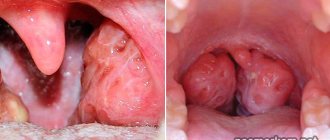Almost every person experiences difficulty breathing through the nose. This is the most commonly diagnosed complaint among patients, because the symptom is associated with a deviated nasal septum. This diagnosis occurs to varying degrees in 80% of the world's population. However, not every patient is bothered by severe discomfort, and therefore not everyone is interested in treatment methods.
In addition to difficulty breathing, patients may experience other symptoms, the intensity of which directly depends on the degree of curvature of the nasal septum.
About mucus in the throat
Mucus in the throat occurs due to the abundant accumulation of phlegm.
Mucus in the throat can accumulate under the influence of various factors associated with both the external environment and diseases of the internal organs. The most common cause of mucus in the throat is diseases of the ENT organs of allergic, non-allergic, as well as bacterial, post-infectious and fungal origin. Abnormalities in the development of the nasopharynx can contribute to the development of mucus in the throat.
Persons who have excessive accumulation of mucus in the throat should be observed by an ENT doctor, since the real cause of this phenomenon is not easy to determine. The main thing is not to self-medicate, so as not to worsen the situation. Mucus in the throat can appear for various reasons. Quite often, mucus in the throat occurs due to abundant accumulation of sputum , which is the first sign of an inflammatory process in the bronchi. To make an accurate diagnosis, you need to consult a medical specialist, that is, an ENT specialist.
A characteristic sign of one of the diseases in which mucus appears in the throat is catarrhal or hypertrophic pharyngitis of a chronic nature. In this case, the inflammation that affects the pharynx area leads to the formation of a lump of mucus, which irritates the mucous membrane, causing the desire to cough.
How to treat mucus accumulation in the nasopharynx with tablets and folk remedies
Before implementing therapeutic measures, you need to understand the cause of pain and accumulation of snot in the nasopharynx. In addition, treatment should involve the use of medications and agents that could eliminate the symptom that has arisen and overcome the underlying factor.
How to cure an adult with a constant or chronic runny nose
The process of eliminating accumulated mucus in adults occurs in several stages. Initially, medications are prescribed to dilute accumulated phlegm. At the same time, rinsing the nose and throat is prescribed.
Clean your nose with furatsilin
To prepare the solution, you can use furatsilin, salts, soda, and potassium permanganate. Since mucus most often accumulates at night, cleansing procedures must be carried out in the morning.
What antibiotics to take for sinusitis are indicated here.
When the nasal rinsing has been completed, and the doctor has discovered an infection in the throat, he decides to prescribe drug therapy. It may include a course of antibacterial drugs, antihistamines, nasal drops and expectorant medications. To consolidate the results obtained, it is worth using effective methods of physiotherapy. They are carried out in a hospital setting.
Instructions for using Gerbion for wet cough can be found here.
A properly formulated diet can also reduce the accumulation of mucus in the nasopharynx.
The patient must be more attentive to what he consumes, since his body must contain the required amount of moisture. For these purposes, you need to drink at least 2 liters of liquid per day. The diet must contain foods containing vitamins C, E and A. In addition, do not forget about breathing exercises and massage, which also has a positive effect on the entire course of treatment.
Nasal rinsing at home should be done only after the patient has held his face over the steam. Such manipulations will help thin the mucus and remove it quickly. To carry out such steam inhalation, you can use hot water in the process, which is left after boiling potatoes, or a decoction based on mint or nettle. The duration of the manipulation is 20 minutes
Throughout the entire procedure, you must carefully inhale the steam alternately through your nose and mouth.
Treatment of children
If we talk about treating children, then it is worth taking into account the fact that their mucous membranes are very delicate and vulnerable. When preparing treatment, the doctor must take this into account and draw up a gentle treatment regimen.
How to get rid of snot in a baby
The most effective and popular procedure is rinsing the nasal passages. To prevent your baby from developing various allergic reactions, you should use light salty products as a solution. They are completely safe and have an excellent disinfectant and mild antiseptic effect. Sometimes doctors prescribe nasal rinsing with saline solution for children.
We recommend that you read about how to treat loss of voice due to laryngitis in this material.
It is necessary to use an antibiotic in the process only when the potential benefits of using medications outweigh the possible danger of side effects on the developing organism. In this situation, the doctor will prescribe the baby to take antimicrobial drugs with a small dose or suspension.
The instructions for Thermopsis cough tablets can be found in this article.
Very often, doctors try to include topical agents in the process, thereby reducing the negative impact of medications on the liver.
Protargol for removing phlegm
Protargol is a safe and effective solution that actively fights accumulated mucus in the nasopharynx. Its composition suggests the presence of proteins and silver ions. Its action is aimed at activating mucus secretion and destroying pathogenic microorganisms. In addition, when used, the mucous membranes dry out, and metabolic processes in the nasopharynx return to normal.
Causes of mucus in the throat
The causes of mucus in the throat are:
- Pharyngitis (inflammation of the pharyngeal walls);
- Sinunsitis (inflammation of the paranasal sinuses);
- Adenoiditis (inflammation of the pharyngeal tonsil).
All of these diseases cause mucus to accumulate in the throat. Increased mucus production in the throat occurs with nasal polyps and a deviated nasal septum. After nasal injuries, complications such as a forced cough may appear. Mucus in the throat often accumulates after a recent illness , such as the flu or ARVI. The cause of mucus in the throat may be a banal manifestation of bronchial asthma. With a disease such as bronchial asthma, mucus is formed in large volumes as a protective reaction of the body, being a means of evacuating allergens that leave the body in this way.
The accumulation of mucus in the throat can be caused by a carbonated drink, hot, spicy or very cold food. Nicotine and alcohol have such a detrimental effect, which irritates the mucous membrane of the nasopharynx, thereby aggravating the condition. All of these factors can cause congestion, which is manifested by a sensation of mucus accumulation in the throat. Most often, this symptom is observed in the morning after waking up. At night, mucus drains down the back of the throat and accumulates in the throat as a result of prolonged exposure to a horizontal position during sleep. Cough in the morning is not accompanied by changes in the lungs, but is characterized by frequent discharge of mucus clots.
Drug treatment
How to remove mucus from the nasopharynx? The process of evacuation of sputum from the respiratory tract can only be facilitated if its viscosity is reduced. For this purpose, secretolytic and secretomotor agents are used. You also need to take medications that help eliminate inflammation in the mucous membranes.
Mucolytic drugs reduce the amount of mucin in sputum, which has astringent properties. A decrease in the concentration of protein components in the mucus contributes to its liquefaction and detachment from the inner surface of the nasopharynx. With the help of secretolytic agents, not only sputum is removed from the respiratory system, but also purulent exudate, which is often formed during the development of sinusitis, purulent pharyngitis, tracheobronchitis, etc.
Mucolytic drugs can be used to treat adults and children over 3 years of age.
To transform a dry cough into a wet one, it is recommended to use:
- "Fluimucil";
- "ACC";
- "Ambroxol";
- "Mukopront."
Expectorant medications increase the sensitivity of cough receptors, thereby accelerating the process of removing mucus from the nasopharynx. During forced exhalation, pathological secretions containing pathogenic viruses or bacteria are evacuated from the lower and upper parts of the respiratory system. The best drugs with secretomotor action include:
- "Sinupret";
- "Ambrosan";
- "Tavilek";
- "Bromhexine."
Treatment with expectorants is indicated for the development of acute bronchitis, cystic fibrosis, tracheitis, bronchial asthma, etc.
Secretomotor drugs prevent mucus stagnation in the lower parts of the respiratory tract. If you do not start taking medications in time, this will lead to disruption of the drainage function of the bronchi and, as a result, the development of pneumonia.
Local anti-inflammatory drugs can accelerate the regression of pathological processes directly at the sites of inflammation. Restoring the secretory activity of goblet cells will lead to a decrease in the amount of sputum in the respiratory tract. To ease the course of the disease and speed up the recovery process, it is recommended to use the following types of drugs:
- "Orasept";
- "Ingalipt";
- "Pro-Ambassador";
- "Hexoral".
Treatment of children with aerosol preparations may provoke undesirable reactions. To prevent negative consequences, doctors recommend treating a sore throat with Lugol's Solution or antiseptic drugs.
Symptoms of mucus in the throat
Typical symptoms of mucus in the throat include:
- Feeling of burning and rawness in the throat;
- Sore throat;
- Unpleasant sensations when swallowing;
- Constant desire to cough;
- Lump in throat.
Common symptoms include headaches and enlarged cervical lymph nodes. When a person begins to experience a sore throat or a pleasant sensation while swallowing, these symptoms may indicate mucus in the throat. In other words, a lump in the throat is felt due to a constant desire to cough.
The method of treating mucus in the throat is determined only by an ENT doctor after a comprehensive examination.
Treatment
Since there can be many reasons for the development of an unpleasant symptom, making a correct diagnosis is of great importance for adequate treatment, which is impossible without a qualified specialist and special medical equipment.
If the cause does not have a pathological basis, then it can often be eliminated by a set of general measures: adjusting the daily diet, giving up bad habits, changing jobs or using personal protective equipment.
However, if you suspect an existing pathology, you must consult a doctor: therapist, otolaryngologist, gastroenterologist, allergist.
Drug therapy
Since in the vast majority of cases, the production of mucus is caused by inflammatory processes of an infectious nature in the nasopharynx, drugs from the following groups of drugs are most often used for treatment:
Antibiotics: penicillins, cephalosporins, macrolides. The drug is selected by the attending physician depending on the severity of the disease and the patient’s health condition. When diagnosing, a bacterial examination of sputum can be carried out in order to identify the pathogen and prescribe the most effective remedy;
- Antiviral: interferons (Grippferon, Viferon), interferon inducers (Lavomax, Arbidol), cyclic amines (Rimavir, Remantadine), neuraminidase inhibitors (Relenza, Tamiflu), herbal (Altabor, Flavozid), etc. The wide range of antiviral agents is due to the difference in their effects for viruses. Many drugs have an immunostimulating effect and can be taken for preventive purposes;
- Antihistamines: Cromohexal, Allergodil sprays, Sanorin-Analergin drops, Koldakt tablets, Orinol. Prescribed only when an allergy to a certain type of irritant is detected after allergy tests have been carried out;
- Vasoconstrictors: Galazolin, Nazivin, Sanorin. They can be prescribed for short-term effects on the mucous membrane in particularly severe conditions. Use for no more than 3-5 days at the recommended dosage. Use during pregnancy and lactation is not recommended;
- Corticosteroids: Flixonase, Beconase, Nasonex. The use of drugs that affect the hormonal causes of a runny nose may be justified when severe swelling occurs due to allergic irritation. The use of this type of remedy, as a rule, occurs in very rare cases.
Folk remedies
Drug therapy, as a rule, requires a certain period of time for a visible effect. But some procedures using folk remedies can help alleviate the patient’s condition from the very beginning:
- Washing. For rinsing, use a weak saline solution (0.5 tsp salt, preferably sea salt, per 200 ml of water), decoctions of medicinal herbs (chamomile, sage, calendula) or special pharmaceutical solutions;
- Rinse. They are the safest, although the most troublesome procedures, especially when treating children. For medicinal solutions, infusions of medicinal herbs, saline soda solution (for 200 ml of water, 1 teaspoon of salt and soda, a few drops of iodine), solutions with the addition of a few drops of propolis can be used;
- Inhalations. For inhalation of the nasopharynx and oropharynx, it is recommended to use a steam inhaler designed to deliver the drug only to the upper respiratory tract. You can also use a regular kettle or saucepan. Alkaline mineral water, boiled potatoes, decoctions of medicinal herbs (eucalyptus, calendula, chamomile) are suitable as medicines;
- Compresses. For throat diseases, a compress helps thin mucus and promotes its evacuation. To alleviate the condition, use fresh cottage cheese, boiled potatoes, cabbage leaves with honey. Any of the products is applied to the neck and wrapped in polyethylene and a warm scarf. Star balm is also used as a warming component. The greatest therapeutic effect of the compress can be obtained when applying it at night.
Treatment of mucus in the throat
Treatment of mucus in the throat at the ENT-Asthma clinic is comprehensive and is aimed at suppressing local symptoms of the disease, affecting the main causes that maintain mucus in the throat. The main task of treating mucus in the throat is to eliminate discomfort. For more effective treatment, painkillers and anti-inflammatory, antiseptic and antibacterial drugs are used.
For local treatment of mucus in the throat, drugs can be used to help moisturize the mucous membrane and relieve sensations that are considered paresthesia - a feeling of soreness and tickling in the throat. In cases where mucus in the throat is a symptom of an infectious disease , atomization of the pharyngeal cavity is used using aerosols of combined action (antiseptic and analgesic). The choice of an antibacterial agent by an ENT doctor largely depends on the identified pathogen in case of moderate and severe course of the disease.
If the mucus in the throat is of an allergic nature, then our specialist doctors use a complex of antihistamines. To treat mucus in the throat, the ENT-Asthma clinic uses immunomodulators , which stimulate the body’s own forces to fight the disease. Simply put, the desired result is achieved by increasing immunity. To effectively treat mucus in the throat, sanitation of foci of infection, the oral cavity and the upper respiratory tract is indicated.
What is sputum
© Hank Grebe/Getty Images
Our body produces mucus that coats certain ducts, such as the respiratory and digestive tracts, to protect and maintain certain functions.
This mucus prevents bacteria and viruses from causing infection.
Moreover, our body produces about a liter of phlegm every day.
Most often we don't notice it, but when the mucus becomes thick and takes on an unusual color, such as yellow, green or brown, it can become a problem.
Accumulations of mucus in infants
Many mothers begin to worry when their baby develops mucus in the nasopharynx. For children of this age, this is a very common phenomenon, since their respiratory system is not yet fully formed. But sometimes such a symptom can actually indicate the presence of a certain disease.
Maybe
How to remove phlegm. What do we have to do?
The first thing to do when an unpleasant feeling appears in the throat is to make an appointment with an otolaryngologist, because only a doctor is able to establish the true cause of its occurrence and prescribe treatment appropriate to the circumstances. However, before visiting an ENT specialist, you can take several measures to improve your condition and remove accumulated mucus.
- Carry out inhalations with decoctions or infusions of herbs, mineral water or saline. This remedy will help soften the mucous membranes and facilitate the removal of discharge.
- Take homeopathic medicines. If the patient suspects the presence of sinusitis or rhinitis of any origin, you can start taking Sinupret or another similar medication. They will help remove swelling and improve nasal breathing, so that more mucus will be removed through the nose and flow down the nasopharynx in smaller quantities.
- Drink at least 2 liters of purified water per day, since the accumulation of discharge is often the result of a lack of water in the body.
- Stop smoking.








